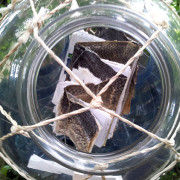SCANZ2013:cyanobacteria

Live cyanobacteria cultured by artist-scientist Hideo Iwasaki is placed into specimen jars in preparation for exhibition
The image above shows preparation work for the 3rd nature exhibition in Puke Ariki. The cyanobacteria was cultured by artist-scientist Professor Hideo Iwasaki of Waseda University, Japan. Professor Iwasaki grows the cyanobacteria in a form derivative of humans, with a head, body, arms and legs.
The cyanobacteria are photosynthetic bacteria, and are ancestors to chloroplasts in plants. A chloroplast captures energy from the sun, and it is said that cyanobacteria helped to make Earth suitable for life. While on exhibition at Puke Ariki the cyanobacteria will be growing slowly, over a period of two months. Instead of the sun, the bacteria will photosynthesise with the light from an animation projected on to them from below.
The work of art and science raises several questions about the boundaries of life and our relationship to living plants. As Professor Iwasaki says: “They will be living at an interface which is hard to be called artificial or natural, drawing complicated patterns, and die.”




